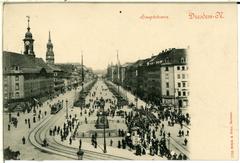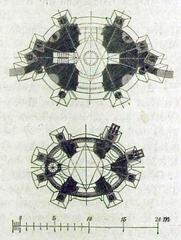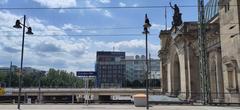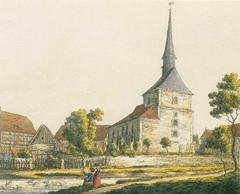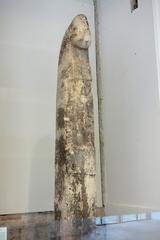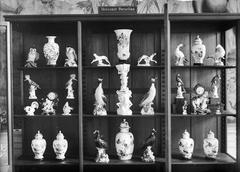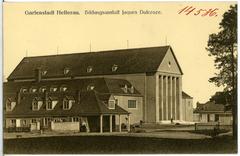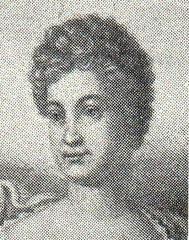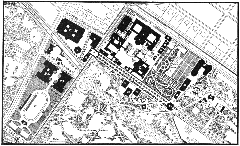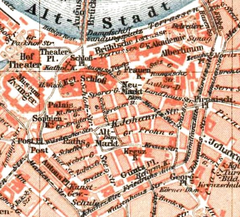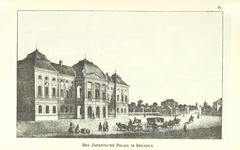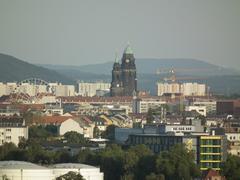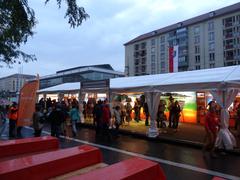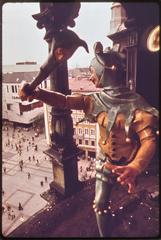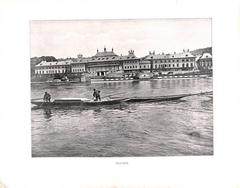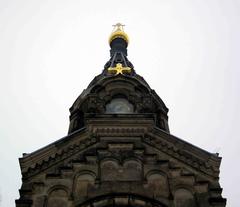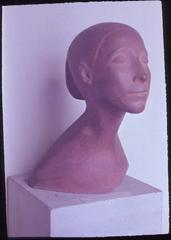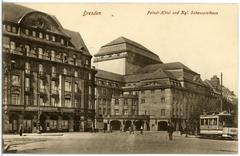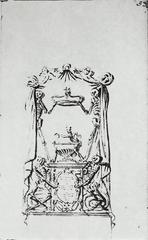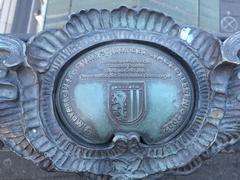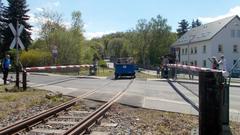
Zionskirche Dresden: Visiting Hours, Tickets, and Historical Site Guide
Date: 04/07/2025
Introduction: Zionskirche Dresden’s History and Cultural Significance
Located in Dresden’s Südvorstadt district, Zionskirche Dresden stands as a remarkable testament to the city’s layered history, architectural evolution, and enduring cultural spirit. This site, often referred to as the Alte Zionskirche or Zionskirchruine, seamlessly fuses its early 20th-century ecclesiastical origins with its modern role as Dresden’s Lapidarium—an open-air museum that safeguards thousands of architectural fragments from destroyed and restored landmarks across the city.
Constructed between 1908 and 1912, the church was a direct result of Dresden’s rapid urban expansion and the visionary legacy of industrialist Johann Hampel. The architectural style reflects a blend of Jugendstil (Art Nouveau) and neo-Romanesque elements. After suffering devastating damage during the Allied bombing of Dresden in 1945, only the outer walls survived, transforming the site into both a poignant memorial and a repository for Dresden’s sculptural heritage.
Today, visitors can experience the evocative remains of the original church alongside the Lapidarium’s extensive collection, which preserves fragments from iconic structures like the Frauenkirche and Semperoper. The active parish has since moved to the Neue Zionskirche—a modernist sanctuary built in the 1980s, symbolizing postwar reconciliation and Scandinavian influences. Zionskirche thus offers a multifaceted experience: a place of worship, a cultural venue, a living memorial, and an enduring archive of Dresden’s resilience and artistry.
For the latest details, visit the Dresden Lapidarium website and the Zionskirche Dresden parish site.
Table of Contents
- Discover the Zionskirche Dresden: A Unique Historical Site and Lapidarium
- Origins and Construction (1908–1912)
- Wartime Destruction and Immediate Aftermath (1945–1950s)
- Transition and Repurposing: From Sacred Space to Lapidarium (1980s–1990s)
- The Lapidarium: Preserving Dresden’s Architectural Memory
- Visiting the Zionskirche Dresden Lapidarium: Hours, Tickets, and Accessibility
- Nearby Attractions
- Architectural and Artistic Highlights
- Historical Significance and Legacy
- Practical Visitor Information
- Frequently Asked Questions (FAQ)
- Plan Your Visit and Stay Connected
- Summary and Recommendations
- References
Discover the Zionskirche Dresden: A Unique Historical Site and Lapidarium
Zionskirche Dresden is more than a church; it’s a site where architectural heritage, memory, and community life converge. As you explore, you’ll encounter both history and living tradition, from its early 20th-century construction to its postwar transformation into the Lapidarium.
Origins and Construction (1908–1912)
The Zionskirche was established during a period of rapid urban growth, funded by industrialist Johann Hampel’s substantial bequest (dresden-zionskirche.de). The foundation stone was set in July 1908, and by September 1912, the church was consecrated, serving a congregation of over 5,600. Designed by Schilling & Graebner, the building showcased Jugendstil and neo-Romanesque styles, featuring striking stained glass windows by Bernhard Müller (de.wikipedia.org).
Wartime Destruction and Immediate Aftermath (1945–1950s)
The Allied bombing of Dresden in February 1945 devastated Zionskirche, leaving only its outer shell standing (de.wikipedia.org). Swedish organizations provided a temporary barrack in 1949, which served both the congregation and the Evangelische Studentengemeinde for over 30 years. Parish life continued in these makeshift spaces until a new church could be built (dresden-zionskirche.de).
Transition and Repurposing: From Sacred Space to Lapidarium (1980s–1990s)
In the late 1970s, the city acquired the ruins, facilitating the construction of the Neue Zionskirche, which opened in 1982 on Bayreuther Straße (de.wikipedia.org). The original site was then transformed into the Lapidarium—a repository for thousands of stone fragments saved from bombed or renovated buildings, including the Frauenkirche and Semperoper (dresden.de). A protective roof was added in 1996.
The Lapidarium: Preserving Dresden’s Architectural Memory
Today, the Lapidarium within the Zionskirchruine houses over 7,100 architectural fragments and sculptures, spanning styles from the Renaissance to the socialist era (de.wikipedia.org). These artifacts offer a unique insight into Dresden’s architectural evolution and the city’s remarkable efforts at cultural preservation.
Visiting the Zionskirche Dresden Lapidarium: Hours, Tickets, and Accessibility
Opening Hours:
- Tuesday to Sunday: 10:00 AM – 6:00 PM
- Closed on Mondays and public holidays
Tickets:
- General Admission: €5
- Reduced (students, seniors): €3
- Children under 12: Free
- Groups/guided tours: Book in advance
Accessibility:
- Wheelchair-accessible with ramps and smooth walkways
- Assistance available upon request
Getting There:
- Tram lines 3, 7, and 12 (Bayreuther Straße stop)
- Limited street parking nearby
- Approximately 20-minute walk from Dresden Hauptbahnhof
Guided Tours and Events:
- Regular guided tours on Saturdays at 2:00 PM
- Art exhibitions, workshops, and cultural events (see official calendar)
Photography:
- Permitted for personal use; professional equipment requires prior approval
Nearby Attractions
- Dresden Hauptbahnhof: Major transit and shopping hub
- Großer Garten: Expansive park for recreation
- Kunsthofpassage: Artistic courtyard with unique murals and cafes
- Frauenkirche, Zwinger Palace, and the Dresden Information Visitor Centre: All within easy reach (dresden.de)
Architectural and Artistic Highlights
The church’s ruins, with their neo-Romanesque arches and surviving stained glass by Bernhard Müller, evoke the grandeur of turn-of-the-century Dresden (alamy.com). The Lapidarium’s atmospheric displays of stone fragments from across Dresden create a compelling narrative of art, destruction, and renewal.
Historical Significance and Legacy
Zionskirche stands as a symbol of Dresden’s resilience—surviving destruction, adapting to new functions, and serving as a memorial to both spiritual resistance and civic recovery (de.wikipedia.org).
Practical Visitor Information
- Location: Bayreuther Str. 28, 01187 Dresden (official website)
- Contact: +49 (0)351 471 70 60 | [email protected]
- Entry: Free for the church; Lapidarium charges apply
- Facilities: Restrooms during events, accessible layout, community hall, no on-site café (cafés nearby)
- Language: Services in German; group tours in English by arrangement
Frequently Asked Questions (FAQ)
Q: What are the Zionskirche Dresden visiting hours?
A: Lapidarium: Tuesday–Sunday, 10:00 AM–6:00 PM. Church: open during services/events; contact office for special visits.
Q: Is there an entry fee?
A: Entry to the church is free. Lapidarium: €5 general, €3 reduced, children under 12 free.
Q: Are guided tours available?
A: Yes, regular tours and special arrangements for groups.
Q: Is the site wheelchair accessible?
A: Yes, with ramps and accessible facilities.
Q: Can I take photographs?
A: Yes, for personal use; restrictions apply during services/events.
Plan Your Visit and Stay Connected
For current events, visiting hours, and updates, consult the official Zionskirche website and Dresden Lapidarium website. Download the Audiala app for guided tours and insider tips on Dresden’s most fascinating sites.
Summary: Tips and Recommendations for Visiting Zionskirche Dresden
- Experience both history and living culture: Explore the evocative Lapidarium and attend community events in the Neue Zionskirche.
- Plan ahead: Check opening hours, event schedules, and book guided tours for deeper insight.
- Combine your visit: Include nearby attractions like the Frauenkirche, Zwinger Palace, and Großer Garten.
- Accessibility: Facilities are designed to accommodate all visitors; reach out for specific needs.
- Stay connected: Use the Audiala app and official channels for updates, virtual content, and travel tips.
Zionskirche Dresden is not just a historical landmark—it’s a vibrant center of faith, art, and community engagement, making it a must-visit site for anyone exploring Dresden’s rich cultural landscape.
References
- Zionskirche Dresden: Visiting Hours, Tickets, and Historical Guide to a Unique Dresden Historical Site, 2025 (dresden-zionskirche.de)
- Zionskirche Dresden: Visiting Hours, Tickets, and Exploring Dresden’s Historic Churches, 2025 (dresden.de)
- Visiting Zionskirche in Dresden: Hours, Tickets, and Cultural Highlights, 2025 (dokmimarlik.com)
- Zionskirche Dresden Visiting Hours, Tickets & Historical Site Guide, 2025 (dresden-zionskirche.de)
- Zionskirche Dresden Wikipedia, 2025 (en.wikipedia.org)
- Tripomatic: Zionskirche Dresden, 2025 (tripomatic.com)
- Dresden Tourism Official Guide, 2025 (dresden.de)











